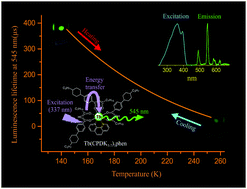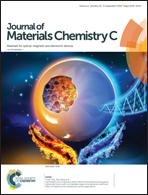A photostable vitrified film based on a terbium(iii) β-diketonate complex as a sensing element for reusable luminescent thermometers†
Abstract
A novel temperature-sensitive luminescent material was fabricated from a powder of a mesogenic terbium(III) β-diketonate complex, [Tb(CPDK3–7)3phen] (CPDK3–7 = 1-(4-(4-propylcyclohexyl)phenyl)decane-1,3-dione, phen = 1,10-phenanthroline) by a melt-processing technique. The material is a 20 μm thick vitrified film sandwiched between two quartz plates. The film effectively absorbs light in the wavelength range of 280–405 nm and exhibits a green narrow-band luminescence of Tb3+ ions due to efficient ligand-to-metal energy transfer. The average luminescence decay time varies reversibly with temperature from 373 μs at 143 K to 33 μs at 253 K having the mean absolute sensitivity of −3.3 μs K−1. The simplicity in design, the high optical transmittance (around 90%) in the visible wavelength region of 450–800 nm, the insensitivity to atmospheric oxygen and the complete resistance to UV light provide technological and operational advantages of the proposed material. The findings demonstrated that the material is promising as a sensing element for luminescent thermometers suitable for long-term temperature monitoring in the range of 143–253 K.



 Please wait while we load your content...
Please wait while we load your content...